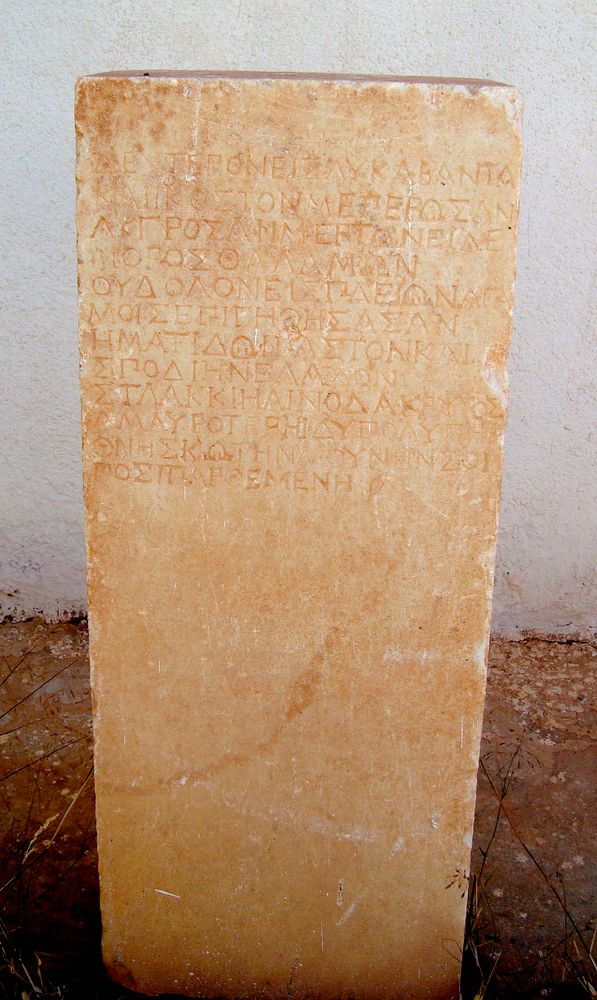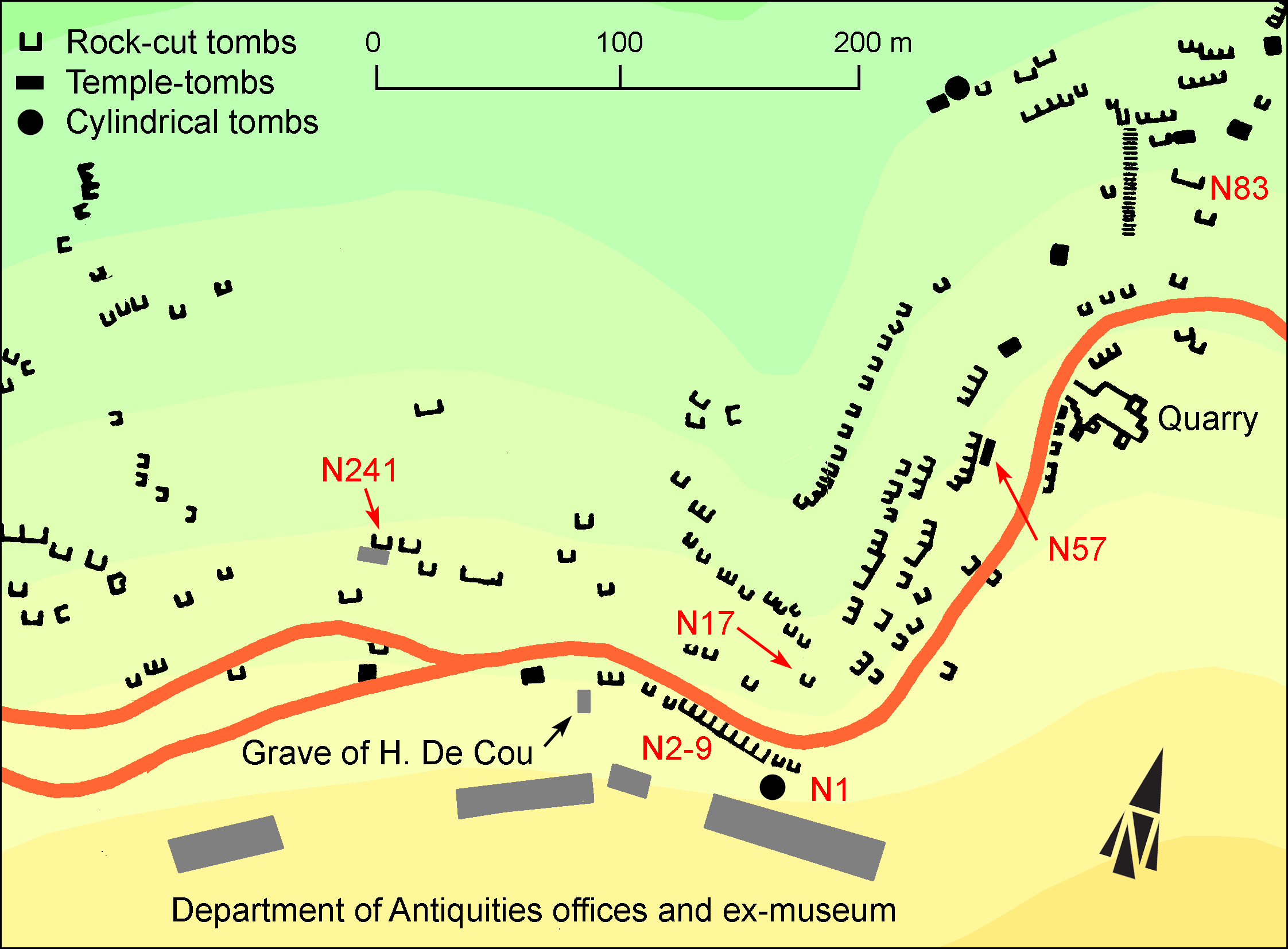EpiDoc XML:
GVCyr0072
Trismegistos ID:
738903
Source description
Support: Plain white marble stele slightly tapering
(w: 0.93 × h: 0.345 to 0.38 × d: 0.22 to 0.23).
Layout: Inscribed on front face in twelve lines, two for each verse,
beginning at 0.055 from the top and ending at 0.61 from the bottom.
Letters: 0.015 to 0.017; very carefully cut inside guidelines still visible; small serifs; alpha with dropped bar, theta with short
central bar, kappa with large oblique bars, slightly slanting mu, large round or oval omicron, rho with square loop, non slanting
sigma, phi with large round loop, developed lower appendices of omega.
Date: Perhaps second half of first century AD (lettering).
Findspot: Found by Dorothy Thorn in 1998 at
Cyrene ➚:
North Necropolis, from tomb N258 Cassels.
Place of origin: Findspot.
Last recorded location: Cyrene Museum, inv. number unknown.
Seen by C. Dobias-Lalou in 2001 in Shahat:
Cyrene Museum.
Text constituted from: Transcription from stone (CDL).
Bibliography
Almuzzeini 1998, p. 269, fig. 1, whence Boter and Tybout in SEG, 51.2212; Reynolds 2003, pp. 168-170, fig. 3 and Dobias-Lalou, BE, 2004.447, whence SEG, 53.2057 and AE 2003.1883; Dobias-Lalou 2014, p. 326, whence SEG, 64.2009; GVCyr 007 ➚.
Text
Interpretive
Δεύτερον εἰς λυκάβαντα
καὶ ἰκοστόν με περῶσαν
λυγρὸς ἀφ᾿ ἱμερτῶν εἷλε
μόρος θαλάμων (vac. 4)
5οὐδ᾿ὅλον εἰς πλειῶνα γά-
μοις ἐπιγηθήσασαν·(vac. 3)
ἤματι δ᾿ὧι παστὸν καὶ (vac. 2)
σποδίην ἔλαχον, (vac. 5)
Στλακκίη αἰνοδάκρυτος·
10ἀμαυροτέρηι δ᾿ὑπὸ λύπηι
θνήσκω τὴν μούνην σοι,
πόσι, παρθεμένη ❧
Metrical
| Δεύτερον εἰς λυκάβαντα | καὶ ἰκοστόν με περῶσαν
| λυγρὸς ἀφ᾿ ἱμερτῶν εἷλε | μόρος θαλάμων (vac. 4)
| (5) οὐδ᾿ὅλον εἰς πλειῶνα γά|μοις ἐπιγηθήσασαν·(vac. 3)
| ἤματι δ᾿ὧι παστὸν καὶ (vac. 2) | σποδίην ἔλαχον, (vac. 5)
5 | Στλακκίη αἰνοδάκρυτος· | (10) ἀμαυροτέρηι δ᾿ὑπὸ λύπηι
| θνήσκω τὴν μούνην σοι, | πόσι, παρθεμένη ❧
Diplomatic
ΔΕΥΤΕΡΟΝΕΙΣΛΥΚΑΒΑΝΤΑ
ΚΑΙΙΚΟΣΤΟΝΜΕΠΕΡΩΣΑΝ
ΛΥΓΡΟΣΑΦ᾿ΙΜΕΡΤΩΝΕΙΛΕ
ΜΟΡΟΣΘΑΛΑΜΩΝ
5ΟΥΔ᾿ΟΛΟΝΕΙΣΠΛΕΙΩΝΑΓΑ
ΜΟΙΣΕΠΙΓΗΘΗΣΑΣΑΝ
ΗΜΑΤΙΔ᾿ΩΙΠΑΣΤΟΝΚΑΙ
ΣΠΟΔΙΗΝΕΛΑΧΟΝ
ΣΤΛΑΚΚΙΗΑΙΝΟΔΑΚΡΥΤΟΣ
10ΑΜΑΥΡΟΤΕΡΗΙΔ᾿ΥΠΟΛΥΠΗΙ
ΘΝΗΣΚΩΤΗΝΜΟΥΝΗΝΣΟΙ
ΠΟΣΙΠΑΡΘΕΜΕΝΗ ❧
French translation
Alors que je m'acheminais vers ma vingt-deuxième année,
un lamentable sort m'a arrachée à mon aimable chambre nuptiale,
sans que j'aie joui de mon mariage jusqu'à une année complète;
et le jour où m'est échu le voile nuptial, m'est échue aussi la cendre,
à moi Stlakkiè, qui mérite des pleurs amers; sous le poids d'un chagrin débilitant,
je meurs, après t'avoir confié, mon époux, cette unique enfant.
English translation
As I was passing towards my twenty-second year,
gloomy fate snatched me from my beloved bridal-chamber,
when I had not rejoiced in my marriage for a full year;
but on the day on which I was alotted a bridal bed was I also promised to ashes,
I Stlakkie, deserving of bitter lament; under the weight of enfeebling pain,
I die, having entrusted you, my dear husband, this only girl (transl. J.M. Reynolds at with some changes)
Italian translation
Mentre mi incamminavo verso il mio ventiduesimo anno,
un destino terribile mi ha sottratto dall'amata stanza nuziale,
senza che io abbia goduto nemmeno per un anno intero delle nozze;
proprio nel giorno in cui ho ricevuto in sorte il talamo nuziale, eccomi condannata anche alla cenere,
io, Stlakkie, che merito amare lacrime. Sotto il peso di un dolore che mi esaurisce,
muoio, dopo aver affidato a te, sposo, questa unica figlia.


